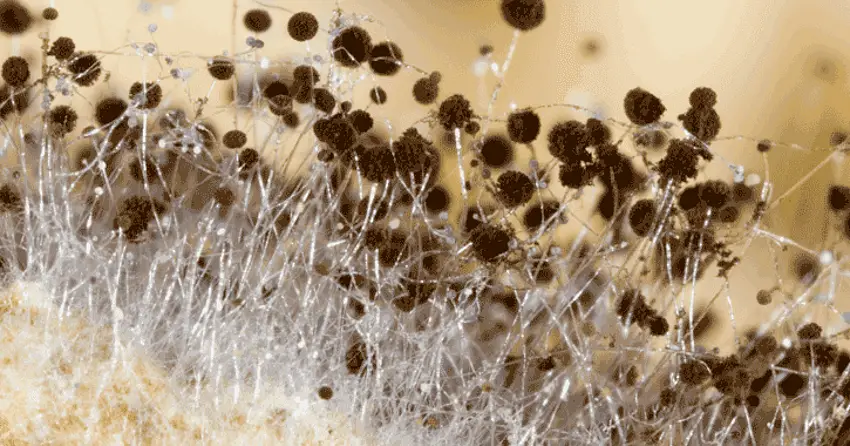Contents
- 1 CLASSIFICATION OF RHIZOPUS (BREAD MOLD)
- 2 STUDY OF HOSTS, DISEASES AND SYMPTOMS OF RHIZOPUS (BREAD MOLD)
- 3 STUDY OF VEGETATIVE STRUCTURE OF RHIZOPUS (BREAD MOLD)
- 4 STRUCTURE – SPORANGIA OF RHIZOPUS (BREAD MOLD)
- 5 STUDY OF SEXUAL REPRODUCTIVE STRUCTURES OF RHIZOPUS (BREAD MOLD)
- 6 IDENTIFICATION OF RHIZOPUS (BREAD MOLD)
CLASSIFICATION OF RHIZOPUS (BREAD MOLD)
Kingdom :- Mycota
Division :- Eumycota
Sub-division :- Zygomycotina
Class :- Zygomycetes
Order :- Mucorales
Family :- Mucoraceae
Genus :- Rhizopus
All the species of Rhizopus are saprophytes, the fungus can be grown on dead organic matter, viz. bread, butter, glycerine, etc., by keeping them in damp and dark conditions. Weak parasitic forms are common on jack fruit and apple which are grown in orchards.
STUDY OF HOSTS, DISEASES AND SYMPTOMS OF RHIZOPUS (BREAD MOLD)
Most of the species of Rhizopus are saprophytie and grow on dead vegetables or animal matter. R. stolonifer grows so frequently on bread that it is often called the ‘bread mold’. It is also called ‘black mold’ for its black coloured sporangia and ‘Pin mold’ for globose sporangia at the tips of branches look like pin heads. Only a very few species viz. R. artocarpi and R. arrhizus are weak parasites. Only a few species of Rhizopus attack the plants.
- artocarpi causes fruit drop of jack fruit (Artocarpus heterophylius; vern. kathal; fam. Moraceae). In fruit drop of jack fruit, the premature fruits are shed due to the attack of the fungus. The attacked peduncles become black in colour.
- artocarpi causes fruit rot of apples (Pyrus malus; vern. sev; fam. Rosaceae). In fruit rot of apples, the apples rot away completely, in conditions of severe infection.
STUDY OF VEGETATIVE STRUCTURE OF RHIZOPUS (BREAD MOLD)
- The mycelium shows abundant, white cottony growth.
- The young mycelium is multinucleate, aseptate, with all the hyphae alike.
- In the older mycelium three parts of hyphae can be distinguished
- branched rhizoids that penetrate the substratum
- stolon or runner growing horizontally above the substratum for some distance and then bending downward, producing another group of rhizoids
- the sporangiophores which grow upward in tufts from the point where the stolons form rhizoids.
STRUCTURE – SPORANGIA OF RHIZOPUS (BREAD MOLD)
- The asexual reproductive structures are sporangia borne by the sporangiophores.
- Each sporangiophore is swollen at the tip and forms sporangium.
- The sporangium has a columella in the centre and the space between columella and wall of the sporangium is packed with aplanospores. This is known as the spore sac.
- The aplanospores are angular or rounded and multinucleate. The spores are colourless or coloured blue or brown with cuticularised or smooth wall showing longitudinal striations.
- Spores are liberated by breaking of the sporangial wall.
- Each spore germinates to form a new mycelium.
STUDY OF SEXUAL REPRODUCTIVE STRUCTURES OF RHIZOPUS (BREAD MOLD)
- The genus is heterothallic and the sexual reproduction takes place only when mycelia of + (plus) and – (minus) strains meet.
- The phenomenon can be demonstrated by a ‘Potato culture plate’ where, on the two opposite ends, mycelia of + and – strains were grown. These met in the centre to produce the zygospores. The zygospores appeared as a black streak in the centre of the potato chip.
- The hyphae of the opposite strains produce erect branches. A transverse division separates the terminal gametangium from a proximal suspensor cell. Suspensor is straight, large and swollen.
- The two isogametangia (also called coenogametangia) conjugate to form a zygospore (zygote) which has a thick wall and rough outer surface.
- Zygospore divides meiotically after a period of rest. It germinates by producing a promycelium which develops a sporangium (often called zygosporangium) at its tip.
- The sporangium produces many multinucleate spores. These germinate to form new mycelium.
IDENTIFICATION OF RHIZOPUS (BREAD MOLD)
- Kingdom – Mycota
- Chlorophyll absent
- Reserve food glycogen
- Cell wall of fungal cellulose.
- Division – Eumycota
- A definite cell wall present.
- Sub-division:- Zygomycotina
- Asexual reproduction by nonmotile spores-aplanospores.
- Class:- Zygomycetes
- Gametangia morphologically similar,
- Sexual reproduction forms a zygospore
- Order– Mucorales
- Mostly saprophytic.
- Asexual reproduction by typical non-motile aplanospores.
- Family – Mucoraceae
- Sporangia with many spores, and well developed columella.
- Sporangial wall relatively thin and easily breakable or deliquescent.
- Genus – Rhizopus
- Sporangiophores arise at rooting nodes of the stolon.


Leave a Reply